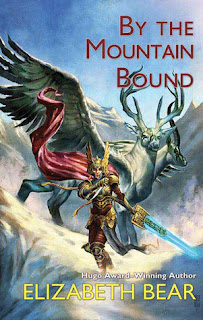When I first read All the Windwracked Stars, I liked it quite a lot, but I never felt quite like I entirely understood the world or what was going on. In that book, Elizabeth Bear throws you in at the deep end, and I was always working to try to put together how the world had gotten to the place it was, and what the intense backstory of the characters was.
Reading By the Mountain Bound first would have helped a lot. I know it was written later, but I feel like I have a much stronger footing in the basic assumptions underlying this world, and would be able to see how it had changed between this time and the much later All the Windwracked Stars.
In this much earlier story, the new world created after what was probably our world fell in Ragnarok, humans live brief flickers of lives while the waelcyrge and einherjar live longer ones, avenging wrongful deaths and creating a society in their own holds, mostly apart from the humans around them. They are led by Strifbjorn, an unmarried einherjar who knows he should wed to help maintain the numbers of his people, but has secrets holding him back.
Then a woman washes up on shore, seemingly human, but also more. Not one of them, but perhaps a manifestation of the Lady they were waiting for to lead them. Definitely with some powers at her disposal, different from the arts of the waelcyrge and einherjar. She prepares them for a coming war, and in the process, starts to change who they are and what is permitted them. Some embrace the new license, others are repulsed.
This story is told through three characters, two of them in first person, one in third. Strifbjorn's sections are told in third person, so we get to know him, but not too close, nowhere near as close as we get to the smallest waelcyrge, Muire, a historian and smith, in love with Strifbjorn, but not blindly so. Or to Mingan, the chained wolf, the Suneater, Strifbjorn's lover and love, who is not quite anything entirely, apart and hurting, causing hurt and taking it in.
The smaller scale emotional upheavals take place as these people try to find or maintain their honour, their places, their homes, and their sense of self in a world that increasingly is upending any stable ground under their feet. These three and the waelcyrge and einherjar who surround them fight, plot, collaborate, are suspicious or jubilant, unleashed or are grimly sure they need to keep their powers under control.
The relationship of these mythological figures to humans comes in to the story as well, as the waelcyrge and einherjar live apart from the human settlements, but venture in, as figures of legend, of vengeance, and, once Heythe, the ostensible Lady enters the scene, of fear. When is it permissible to take a life? What is vengeance and what is revenge? When one is hurt, how much hurt can one impose on others? Is it somehow better if it is done dispassionately, or from a lust for power?
Bear is going for as complicated and deep hurting issues as ever, which is one of the main reasons I love her books (although Karen Memory, of late, was a delightful diversion into lighter territory, and I am fond of both modes). Few authors go this deep, think this hard, and create characters to whom these issues are not abstract concerns, but the pressing matter of their lives.

No comments:
Post a Comment